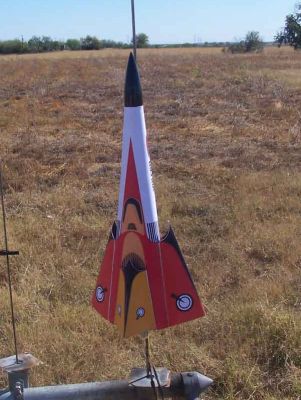 Brief:
Brief:
Since I was a kid, I have always been captivated by the paper shrouded rockets like "The Point". My biggest nemesis, however, was always the Centuri Vulcan. I built lots of them but never got one to behave or even look very good...until I became a BAR and cloned one. It's not the best flier in the world, but it actually works which is more than I can say about any that I built in the '70s.
Recently, I have been in contact with Blades from TRF about his 24mm upscale and he kindly sent me the PDFs for the shrouds. After some conversation, we mentioned other scales and I mentioned that I used to be an engineer and still had a color plotter that handles media up to 5 feet wide and 300 feet long. This also means no splicing of the shrouds!
I tried to print first on a sheet of posterboard, but the plotter did not like that. The media was too thick. I visited the local paper distributor and found 130# cardstock that was less expensive, bigger, thinner, and stronger than the posterboard. I ordered some sheets and resolved to give it a try.
It took some trial and error, but I found that landscape orientation would actually work.
Construction:
The parts list:
- 2 sheets of 26" x 40" 130# cardstock
- BT-60 x 18" tube
- 3-1/4" x 6" launch lugs
- piece of typing paper
- piece of 1/4"x6"x6" balsa
- BT-60 Nosecone of choice
- Cygnus 29mm to BT-60 motor mount
- FlisKits BAF60 Baffle
After printing out the shrouds, the first step in construction was to cut out the cardstock pieces. I cut the body shroud right on the lines and then rolled it up and kept it that way with some rubber bands so that I would have an easier time rolling the body later. The other pieces were not cut so close. I wanted to leave the fold lines visible so that I could pre-fold them before doing the final cutting.

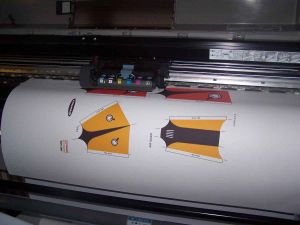
For the 2 wings, the tail, and the airscoop, I used a ruler to fold along the centerlines and make sure the creases were sharp and straight. The ruler was then used to fold under the mounting tabs. Only then was the excess material cut away.
Like the original, this Vulcan has a choice between 2 different style cockpits. One is simpler to construct than the other but the more difficult one is reputedly more in keeping with the overall design. I like both cockpits. On one of my normal size clones, I put both on and called it the Vulcan Trainer. I may do the same with this one but for now, I went ahead and constructed both.
The cockpits were pre-folded and then cut out. White glue was used to fasten the tabs and produce the 3D cockpits.
The aft bulkhead was cut out and then a circle cutter was used to remove the center circle. The outline was then traced onto a piece of 1/4" x 6" x 36" balsa.
The rubber bands were removed from around the body shroud and it was test fit around a BT-60 tube. It fit just right. An extremely small amount of glue was put on the first 3" of the tab and the two halves were pressed together. They were then pulled apart and the glue allowed to dry. The same thing was done with the aft end. Then a small bit of additional glue was applied to the forward end of the tab and it was pressed together around a BT-60. Alignment was carefully checked and the resulting cone was held together with my fingers for about 3 minutes. When it was dry enough that there was not risk of the seam popping, I glued the aft end similarly, checking for alignment along the length of the shroud. The middle section was not yet glued.
After the ends had dried, I slowly started tacking down the rest of the seam, working from front to back and using a double glue joint. By doing this, I was able to keep the edge of the shroud right on the line, and, as I realized there would be a small bubble from not having everything perfectly taut, that bubble would be hidden under the air scoop to be installed later.
As the body shroud was drying, I used a circle cutter to remove the inner circle from the after bulkhead. The after bulkhead color plate was then glued in place and allowed to dry.
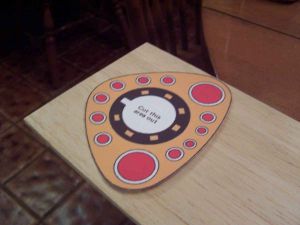
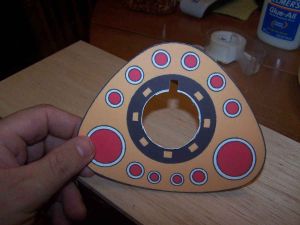
One of the things that made my normal scale clone Vulcan finally work right was the incorporation of an internal launch lug. I soon learned that for things to go right out in the field, the lug needed to run the length of the BT. Doing that was problematical when using just the pieces of lug I had on hand. This time, I wanted to use a single piece.
I finally found a 34" length of 1/4" launch lug at Balsa Machining Co. It was quite reasonably priced at $1.50 but then I learned the shipping policy. There was a $6 flat fee for shipping plus a $3 surcharge for placing the order through the mail. That would have brought the price of my launch lug up to $10.50. Instead, I bought a package of 6" lugs made by LOC from my local hobby shop and decided to splice them.
I started with 2 lugs and ran a piece of 1/4" through them to keep them aligned. I then cut out a 3" wide strip of typing paper and smeared some white glue on one end. The two pieces of lug were butted together and set on the end of the paper and the glue was allowed to dry. A toothpick was then used to smear a thin layer of glue on the unrolled section of paper and it was tightly wound about the butt joint between the two lugs. Keeping the paper tight is the key to keeping the 2 lugs aligned. When the first splice was completed, I added another 6" lug for a total of 3.
I printed up a second sheet of the page with the fins, tail, and air scoop. I cut these elements out just as I did with the first set but a few differences. I did not pre-fold the second set. I also cut off the tabs intended for gluing. These were to serve as the "inner" surfaces.
I mated up each of the inner surfaces with its corresponding outer surface and did a bit of trimming where needed. I placed an outer surface face down on the table and then test fit the inner surface. I wanted it to come right up to the glue tab but still allow the tab to fold around it. White glue was then applied to half the outer surface and smeared to cover it. The inner surface was set in place and pressed flat and then allowed to get tacky. When the joint was stable, I applied glue on the other half and pressed the rest of the inner surface into position.
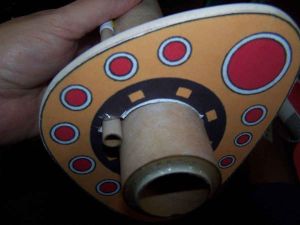
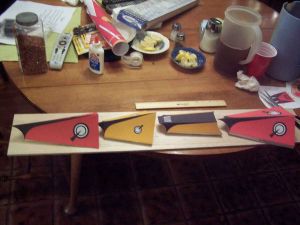
At this point, the aft bulkhead consisted of a piece of 1/4" balsa with a hole in it and the color plate glued to its surface. I started to shape it up by using an X-Acto saw to trim off the corners and remove bulk material. A belt sander was then used to shape it to the outline of the color plate.
It seemed as if making a double layer for the fins had really stiffened them up. They were more or less bent into the right shape and the mounting process began.
I started with the tail fin. A layer of white glue was applied to one of the tabs. It was then pressed into place and immediately removed and the glue allowed to dry. When dry, a bit more glue was applied to the tab and the fin was again pressed into place and held until the glue set enough not to move. This was allowed a full hour before any more work was done.
When the one side was completely dry, the process was repeated on the other side. I waited between sides because these double layer appendages are stiff and I did not want to displace anything.
I ordered a Cygnus 29mm to BT-60 Motor Mount from Uncle Mike's Rocket shack to use in this project. When it came in, construction of the motor mount was simplicity itself.
The motor tube was marked 1/4" from one end. The two centering rings were then test fit around the tube. One fit just fine and the other needed a good bit of sanding to fit around the motor tube. Once they fit, I placed one even with the 1/4" mark and the other flush at the end. The rings were then epoxied in place with 5 minute epoxy. A thrust ring was provided and epoxied into the end with the flush centering ring. When the epoxy on one side was set, I turned it over and painted in on the other, building up a good fillet on the aft ring an sealing together the thrust ring, motor tube and centering ring on the forward end. After that, it was just a matter of waiting for the epoxy to cure.
For my upscale Vulcan project, I needed BT-60 tubing longer than the 18" that comes standard from Estes. I decided to kill two birds with one stone and use a baffle for the coupler. I chose the FlisKits BAF60 Baffle since I had good luck with their BAF55 in the past.
The first step in assembly of the baffle was to thread the Kevlar thread through the provided hole in the after baffle plate. I've had trouble doing this before but this one fit just fine. The Kevlar was knotted and then passed through a notch in the outer edge of the baffle plate so that it would pass up through the baffle. The plate was secured in place with epoxy and epoxy was "painted" over the face of the baffle plate and the interior of the coupler to act as an ablative surface. When the epoxy had set, the Kevlar thread was fed through the notch in the forward plate and that was installed with epoxy as well. I spent more time waiting for the epoxy to set up than in actually putting this thing together.
The motor mount was installed in a full length BT-60 tube and the motor tube protruding just a touch from the end with 5 minute epoxy. When the epoxy was stiff, I set the body tube down on its forward end and mixed another small quantity of epoxy. This was poured into the gap between the motor tube and the BT.
One of the decisions I had to make was about the nosecone. I did not have the gumption to try and research getting and exact upscale copy fitted for a BT-60. Instead, I bought a package of Estes BT-60 cones and picked one from the two styles available. One was a Big Bertha type that is probably a better match but I chose the ogive. I sanded down the seam and then poured in some BBs to serve as nose weight, following them with some epoxy to hold them in place. I put just a touch under 4oz, probably too much, but I wanted my 29mm motors to have to do a little work and I want to get the rocket back. I then painted the NC gloss black.
I took the tube with the motor mount and marked it at 9" from the aft end and cut it at this point. I then took the tube with the baffle coupler and joined the two together with yellow glue. This puts the baffle fairly far back in case another has to be installed at some point as a replacement. I figured that with the nose weight I added, it should be alright. I did not cut the forward tube at this point, preferring to wait until a later step.
I had been taking my time installing the fins, tail, scoop, etc., wanting to make sure that each component is in the exact right place. After joining the body tubes, I finally installed the last fin.
The built up launch lug I had put together earlier was glued to the BT with yellow glue. The paper wraps I had used to join the lugs acted like small standoffs were used to do the actual gluing. I set the lug back just far enough to protrude penetrate the aft bulkhead.
The body tube was inserted into the after bulkhead, aligned and epoxied into place.
When the epoxy joint between the bulkhead and the BT was firm, the assembly was slid into the shroud as far forward as it could go. The impression of the launch lug could be seen on the shroud and an X-Acto was used to cut a notch to pass it. The tube and bulkhead were then seated the rest of the way forward and glued into place.
As the bulkhead and BT assembly was drying into place in the shroud, I glued the cockpit into place with white glue. I decided to go with the more rounded version since it seemed to fit the contours of the rocket better.
I had the shroud glued in place and the BT extended quite a bit in front. Now that everything was positioned as I wanted it, it was time to cut the excess BT from the front of the rocket. I used the shroud as a guide to draw an X-Acto blade around the tube multiple times. Each time went a little deeper until the tube was cut.
One of the things that worries me about this rocket is the stress on the appendages under the boost of a mid-power motor. The fins, tail, and scoop were all put on with white glue. To strengthen the joints, I mixed some epoxy and filleted the joints. I have no doubt this is stronger but it very much affected the appearance of the shrouds wherever the epoxy was in contact. To remedy this, I set the Vulcan up in the spray booth and began to give it multiple coats of Krylon Clear. This mimicked the "wet" appearance of the epoxy and the rocket a more uniform appearance.
Finishing:
Most of the finishing for this rocket is "pre-done" in the pre-printed shrouds. The only thing I added was the spraying of the Krylon clear coat. This gave the ink-jet printed shrouds a bit of protection and tended to hide the epoxy.
Other than that, I sprayed a black plastic nosecone with glossy black paint.
Flight:
The maiden flight of the Vulcan 60 was on a Roadrunner F60-4. It took off and emulated the behavior of its smaller sibling, wagging its tail all the way. The chute deployed on time and it drifted down not too far away. I did learn that the baffle was not enough by itself to protect the chute in this rocket. There was a bit of shredding and lots of little holes. Even so, I judged it worthy of another flight.
Video of the first flight can be seen here.
For the second flight, I wanted to try a Roadrunner G80. I learned, however, that this particular motor would not fit in the motor mount. An Aerotech G would because of the smaller diameter at the ejection end. I loaded an AT G77-7R. It took off and flew well but still corkscrewed. It was noticed, however, that the corkscrewing did not begin until well into the flight. Upon recovery, a small tear was noticed in the shroud. It did not seem to be from landing.
Video of the second flight can be seen here.
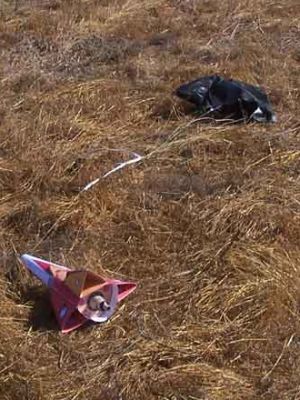
Recovery:
A Kevlar shock cord was installed in the baffle and tied off to a long piece of sewing elastic. A 32" Thermal Rider parachute was donated by Hartle Engineering for this project. It was assembled according to it's simple instructions and connected with a snap swivel.
The first flight damaged to parachute some with bits of burning debris. I attribute this to the baffle being located just forward of the motor mount and getting the full brunt of its fury at ejection. This is contrary to recommended practice but I did it there to give more room for the chute. I needed it. Still, the chute was tough enough to survive, bring the rocket down safely and even be used for a second flight. A regular plastic chute would not have worked under the same circumstances.
I did add 3 pieces of wadding for the second flight and there was no further damage.
Summary:
This really is not a product so much as a project. I like the Vulcan and already have a BT-70 version in mind with a 7 x 18 cluster mount.
#Related Reviews
- Centuri Vulcan By Bill Eichelberger
As a part of the Centuri "paper brigade" that included the Point and the X-24 Bug, the Vulcan always looked like an intriguing rocket to clone. Despite having printed out the patterns I couldn't bring myself to start the project. Something about the idea of constructing a rocket out of pre-printed ...
- Scratch Big Blue Vulc By John Lee
BT70 Upscale of Centuri Vulcan with 7x18mm Motor Mount Construction began with the building of the 7x18mm motor mount from Fliskits meant for the BT70 tube. This was interesting in that normally, 7x18mm mounts will not fit in this tube without some deformation. Fliskits came up with an ...
Related Products
Sponsored Ads
 |
 |











